Beute Sherman is a German Tank unit.
Overview[ | ]
The ubiquitous M4 Sherman medium tank evolved from the M3 Lee medium tank pressed into service as a stop-gap model in 1941. Designed by the U.S. Army Ordnance Department, the tank built upon proven technologies developed for American tanks of the 1930s, combining them with British experiences in tank design. The result was a versatile, reliable, and cheap tank much like the Soviet T-34.
The M4 entered service in late 1942, outperforming its older sibling in every aspect, the Sherman went on to become one of the most widely produced armored fighting vehicles of World War II. It was well armored, relatively fast, and cheap to produce, becoming the backbone of Allied armored divisions across the world and a major element of the Lend-Lease program for the Soviet Union. Nearly 50 000 tanks were produced before production ended in 1945 and were used across the world.
The M4A2 sub-designation indicates a second-generation Sherman, with a 75mm medium-velocity general-purpose gun, Diesel-powered General Motors Twin G-41 Engine and powertrain from earlier M3A3/M3A5 Stuart tanks. The M4A2 was the first model manufactured with a welded hull and although none were used by the US Army in combat, barring some DD conversions for the Omaha landing, they found use in French, Polish, and Soviet units. The Beute adjective indicates a Sherman captured by the Nazis and pressed into service as Panzerkampfwagen M4 (74a).
M4A3[ | ]
The M4A3 sub-designation indicates a Sherman model manufactured with a Ford GAA V-8 engine, welded hull and either the 75mm medium-velocity general-purpose gun or 76mm medium-velocity general-purpose gun.
M4A3(75)W[ | ]
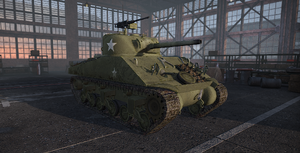
A M4A3(75)W.
The M4A3(75)W sub-designation indicates the mainstay of the U.S. Army, an M4 Sherman model with a new Ford GAA V-8 engine, a welded hull, and the M3 75mm gun. These were only built by Fisher Body with 2420 units build. These tank were the last Sherman designed to carry the 75mm cannon.
- M4A3(75)W (SD2): The basic variant.
- Char M4A3(75): The French equivalent.
- M4A3(75)W Spahis: The French equivalent assigned to The 1e escadron of 1er Régiment de Marche de Spahis Marocains. These Shermans replaced M3A3 Spahis
M4A3(76)W[ | ]
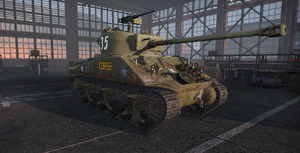
A French M4A3(76)W in the armory.
The M4A3(76)W sub-designation indicates an M4 Sherman model with the Ford GAA V-8 engine, a welded hull, and the superior M1 76mm gun for engaging enemy tanks.
- M4A3(76)W: The basic variant.
- Char M4A3(76) (SD2): The French version.
M4A3E2 Jumbo[ | ]
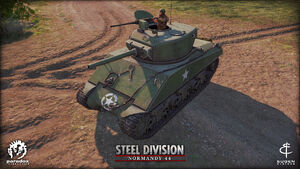
A Jumbo variant of the M4A3.
The M4A3E2 (Jumbo) sub-designation indicates a M4A3(75)W tank modified with an additional 8 tons of armor, bringing the total thickness of the frontal glacis to 101.6mm for an effective frontal armor of nearly 180mm, together with a redesigned T23-style turret. 254 Jumbos were built at the Fisher Tank Arsenal and shipped to Europe to act as assault tanks, aiding infantry in breaking out of the Normandy beachhead.
M4A3(W) Calliope[ | ]
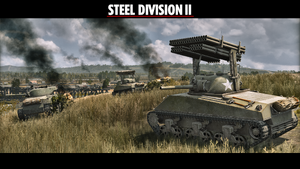
Two Calliope tanks with a Jumbo
The Calliope designation identifies a Sherman with a 60 tube T34 multiple launcher system utilizing the M8 rocket. The rocket itself was developed in the 1940s at Picatinny Arsenal and entered service in 1943. The M8 was designated as a barrage rocket due to its low accuracy, and thus fired in large volleys from MLRS, becoming the first of Allied grid erasers.
M4A3(105)W[ | ]
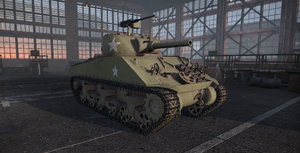
A variant rearmed with the 105mm M4 Howitzer for direct fire support, with marginal anti-armor capability.
- M4A3(105)W (SD2): The American variant.
- Obusier M4A3 (SD2): The French variant.
M4A4[ | ]
The M4A4 is a sub-designation indicates a Sherman equipped with 75 mm M3 L/40 gun and Chrysler A57 multibank 30-cylinder "cloverleaf" petrol engine.
Sherman V[ | ]
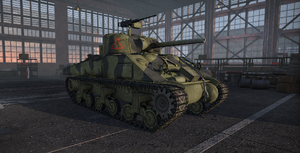
A Sherman V in the armory.
Sherman V is a Lend-Lease designation for the M4A4 Sherman.
- Sherman V: The basic variant.
- Sherman V (Can) (SD2); Sherman V (SA), Sherman V (Pol) (SD2): Sherman Vs used in service of Commonwealth units.
- CMD Sherman V (SD2) Sherman V CO (SA), : A platoon commander's tank.
- Sherman V C.O.: A British Armored Regiment commander's tank.
- Sherman V Recce (SA): Recon version used by South African units.
Sherman V DD[ | ]
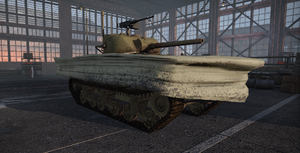
A Canadian Sherman V DD (A Sherman V fitted with the Duplex Drive and flotation screens)
A M4A4 Sherman fitted with the Duplex Drive and flotation screens.
- Sherman V DD: The basic variant.
- Sherman V DD CMD: A platoon commander's tank
Conversions[ | ]
M10 tank destroyer[ | ]
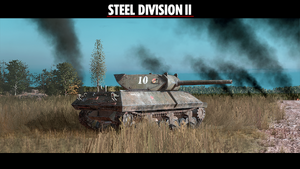
A Lend-Lease M10 in Belarus.
The battle of France saw the birth of Blitzkrieg when German tanks were employed in an offensive role en masse for the first time. US tank doctrine envisioned mass enemy armored thrusts piercing through front lines, and to combat this perceived threat they called for a fast, well-armed tank destroyer that could react to such an attack. The M10 was one of the first tank destroyer models introduced into U.S. service after its entry into World War II. It combined a Sherman chassis with the 3-inch M7 anti-aircraft gun mounted on an open-top turret. To be fast, it had to sacrifice armor. The combination of an open top and thin armor made the tank destroyer vulnerable to German anti-tank weaponry, but especially small arms and artillery. Advantages of an open top included ease of communication, a quick way to get out of the tank when hit and great visibility, helping crew members spot tanks from afar.
The destroyer, formally designated 3-inch Gun Motor Carriage M10, was developed by the Fisher Body division of General Motors and Ford Motor Company in early 1942. It mated a modified M4A2 (M4A3 in M10A1 models) Sherman chassis with the M7 76.2mm gun in a rotating turret. It was a reliable and powerful weapon during its production run from September 1942 to December 1943. Although its main gun was eventually found to be ineffective against heavier German tanks such as the Panther. The kind of battlefield that bare witness to massed armoured attacks as envisioned by US tank doctrine was never fully realised and the tank destroyer often fulfilled the role of direct and indirect fire support. While the M10 TD had its shortcomings, tank destroyer battalions equipped with the Wolverine still caused many German armour losses. It proved to be a potent general support unit pressed into many roles.
The nearly 6,500 M10s produced remained in service until the end of the war. A further 1648 vehicles were supplied to the United Kingdom, which converted 1017 of them into the 17-pdr armed Achilles. Around 200 Wolverines were also supplied to the Free French army.
M10[ | ]
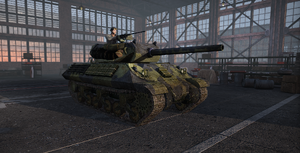
An Canadian M10.
The basic M10.
- Wolverine (UK): The British version.
- Wolverine (Can) (SD2): The Canadian version.
- Wolverine (Pol): The Polish version.
- M10: A lend-lease M10 tank destroyer to the Soviet Union.
M10A1[ | ]
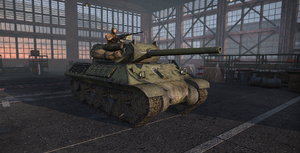
An American M10A1.
A M10 variant based on the M4A3 Sherman chassis
- M10A1 Destroyer (SD2): The American version.
- TD M10A1 (Fr) (SD2): The French version used by Régiment Blindé de Fusiliers-Marins.
- TD M10A1 RCA : Another French version used by 8e Régiment de Chasseurs d’Afrique.
- Char M10A1 RCA A French M10A1 used in the tank role
Achilles[ | ]
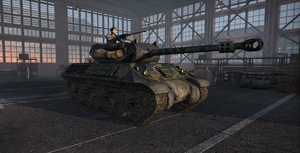
A British Achilles in the armory.
The Achilles was the British variant, rearmed with a 17 pounder, Self-Propelled, Achilles was a British variant of the American M10 tank destroyer armed with the British Ordnance QF 17 pounder anti-tank gun in place of the standard 3" (76.2 mm) Gun M7. Unlike the American who used their M10 as tank hunters, United Kingdom used theirs as a mobile anti-tank gun.
- Achilles (UK) (SD2): The basic variant.
- Achilles (Can), Achilles IIc (SD2): Achilles used in service of Commonwealth units.
Firefly[ | ]
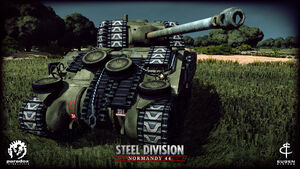
A Sherman Firefly in the field.
The Firefly conversion combined the powerful Ordnance Quick-Firing 3-inch (76.2mm) 17-pounder anti-tank gun inside a revamped turret with the versatile Sherman chassis, giving Allied forces a tremendous advantage in combat with the Axis. The 17-pounder was capable of reliably destroying Panthers and Tigers in combat.
Officially, the conversion was identified by appending c to the hull designation (i.e. M4 was the Ic, M4A1 IIc, M4A2 the IIIC, M4A4 the Vc etc.) The Firefly or Mayfly nickname was given to it by tank crews and soldiers, due to its highly visible, distinctive muzzle flash.
Variants include:
- Firefly Ic (SD2): Conversion based on the Sherman I.
- Firefly (UK); (Can) (SD2); (Pol) (SD2): Modfications of the standard Sherman V.
- Firefly Harris: A tank ace, representing Sgt. Wilfred Spit Harris.
- Beute Firefly (SD2): A captured Sherman Vc.
21. Panzer created a unit using 4 captured Shermans.
Strategy[ | ]
| |||||||||||||||||||||||||||||||||||||||||||||||||||||||||














